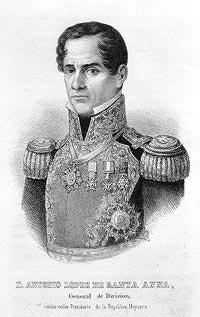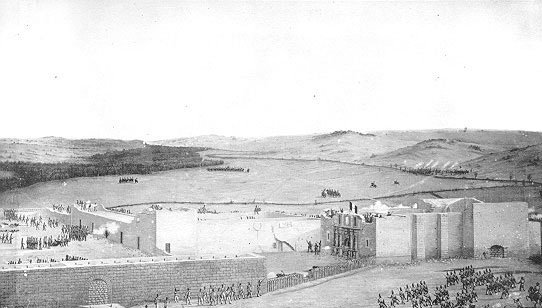The Fall Of The Alamo
From October 1835, Texans in the field had succeeded in most of their
military campaigns. The cannon at Gonzales remained, smaller military
units surrendered and then retired to Mexico, and Bexar finally gave way
after a two-month siege. When Martin Perfecto de Cos and his men retreated
from Bexar in December 1835, Texas had eliminated the last of the Mexican
garrisons. Most of the volunteers returned to their homes, convinced the war was
over. The provisional government, split by internal quarrels over the
objectives of the war, failed to supply the men in the field adequately.
What little remained of the munitions and supplies were further subject
to confiscation by commanders proposing buccaneering expeditions to Matamoros.
By January, the small body of men commanded by James C. Neill were reduced
to about 100. They were supplemented by some twenty-five volunteers commanded
by Brother James Bowie. Brother Travis arrived on February 3 with thirty
men from the regular army, ordered there by Governor Henry Smith. In spite of engineer Green B. Jameson's belief that the Alamo was indefensible,
both Neill and Bowie saw the fortress as a strategic post, particularly
because of its armament. Houston, on the other hand, preferred to avoid
fixed fortifications, and ordered Bowie, subject to Henry Smith's approval,
to blow up the building. When James C. Neill left the city a few days later to deal with illness
in his family, he left Travis in command. Bowie, however, as commander
of the volunteers, refused to accept orders from a regular army officer.
A divisive contest was avoided when Bowie became ill and was forced to
accept the arrangement.
Santa Anna crossed the Rio Grande on February 12, and - a month earlier
than expected - he arrived outside Bexar on February 23. Travis dispatched
a note to Gonzales calling for reinforcements and numbering the defenders
at 150. The next day he wrote his Letter from the Alamo, probably the best
known of all Texas documents. Reinforcements under Captain Albert Martin arrived from Gonzales on March
1. With the arrival of the last of Santa Anna's forces, Travis was able
to send out only one last appeal on March 3. Again, he echoed the determination
of the fortress to withstand surrender: "A blood red banner waves from
the church of Bejar, and in the camp above us, in token that the war is
one of vengeance against rebels: they have declared us as such, and demanded
that we should surrender at discretion, or that this garrison should be
put to the sword. Their threats have had no influence on me, or my men,
but to make all fight with desperation, and that high souled courage which
characterizes the patriot, who is willing to die in defence of his country's
liberty and his own honor…"
Fall of the Alamo, by Theodore Gentilz
After the battle, the Texan bodies were burned. The pyre was constructed
about three o'clock in the afternoon of March 6, and was lighted about
five according to Francisco Antonio Ruiz, who went on to report: "The
gallantry of the few Texans who defended the Alamo was really wondered
at by the Mexican army. Even the generals were astonished at their vigorous
resistance, and how dearly victory was bought… The men (Texans) burnt
were one hundred and eighty-two. I was an eyewitness, for as alcalde of
San Antonio, I was with some of the neighbors, collecting the dead bodies
and placing them on the funeral pyre." After the fall of the Alamo in 1836, the church and buildings were largely
abandoned. The government of the Republic returned the chapel to the Catholic
Church, but after annexation, the U.S. Government claimed it again for
military use. In the ensuing years, both U.S. and Confederate forces used
the building to house quartermaster stores and munitions. The U.S. Army
continued to lease the property until 1876. Bishop John Claud Neraz's
offer to sell the Alamo in 1882 was made to Frank W. Johnson, first president
of the Texas Veterans' Association. He, in turn, passed the information
on to the governor with a recommendation that the State purchase the building.
On April 23, 1883, the Texas legislature passed an act authorizing the
purchase of the Alamo. Money from the sale went to complete a
new chancery building for the San Antonio diocese.
No ę Copyright.
|
Page Crafted By Corky
The Pine Island Webwright







